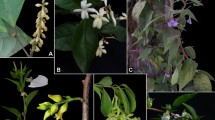Abstract
Fucosterol (2), oxygenated fucosterol, 24-ethylcholesta-4,24(28)-dien-3,6-dione (3), β-sitosterol (1), and daucosterol (4) were isolated from ethyl acetate (EtOAc) fraction of Osmanthus fragrans var. aurantiacus flower by repeated silica gel, octadecyl silica gel, and Sephadex LH-20 column chromatography. The sterol structures were determined based on spectroscopic methods including nuclear magnetic resonance, infrared spectroscopy, fast atom bombardment mass spectrometry, and electron ionization mass spectrometry. Fucosterol (2), oxygenated fucosterol, and 24-ethylcholesta-4,24(28)-dien-3,6-dione (3) are representative sterols mainly isolated from marine algae, but rarely found in land plants. This is the first reported isolation of these sterols from O. fragrans var. aurantiacus. Interestingly, the oxygenated fucosterol (3) isolated inhibited the in vitro growth of the HCT-116 human colon cancer cell line with higher cytotoxic effects than doxorubicin, a well-known cytotoxic drug.
Similar content being viewed by others
References
Akbay P, Cahs I, Heilmann J, and Sticher O (2003) New stigmastane sterols from Ajuga salicifolia. J Nat Prod 66, 461–465.
Chang KC, Duh CY, Chen IS, and Tsai IL (2003) A cytotoxic butenolide, two new dolabellane diterpenoids, a chroman and a benzoquinol derivative formosan casearia membranacea. Planta Med 69, 667–672.
Choi YJ (1999) In Cultivation Techniques of Tree, O-Sung Publishing Company, Seoul, Korea.
Deng C, Song G, and Hu Y (2004) Application of HS-SPME and GC-MS to characterization of volatile compounds emitted from Osmanthus flowers. Ann Chim 94, 921–927.
Ham YM, Kim Kn, Lee WJ, Lee NH, and Hyun CG (2010) Chemical constituents from Sargassum micracanthum and antioxidant activity. Int J Pharm 6, 147–151.
Lee HH, Lin CT, and Yang LL (2007b) Neuroprotection and free radical scavenging effects of Osmanthus fragrance. J Biomed Sci 14, 819–827.
Lee JH, Lee JY, Park JH, Jung HS, Kim JS, Kang SS, Kim YS, and Hana YM (2007a) Immunoregulatory activity by daucosterol, a β-sitosterol glycoside, induces protective Th1 immune response against disseminated Candidiasis in mice. Vaccine 25, 3834–3840.
Lee SH, Lee YS, Jung SH, Kang SS, and Shin KH (2003) Antioxidant activities of fucosterol from the marine algae Pevetia siliquosa. Arch Pharm Res 26, 719–722.
Lee YS, Jung SH, Lee S, Choi YJ, and Shin KH (2002) Hepatoprotective and anti-diabetic effects of Pelvetia siliquosa, a marine algae, in rats. J Appl Pharmacol 10, 165–169.
Ohtsu H, Xiao Z, Ishida J, Nagai M, Wang HK, Itokawa H, Su CY, Shih C, Chiang T, Chang E, Lee YF, Tsai MY, Chang C, and Lee KH (2002) Antitumor agents. 217. curcumin analogues as novel androgen receptor antagonists with potential as anti-prostate cancer agents. J Med Chem 45, 5037–5042.
Oh YS, Lee IK, and Boo SM (1990) An annotated account of Korean economic seaweeds for food, medical and industrial uses. Kor J Phycor 5, 57–71.
Sheu JH, Wang GH, Sung PJ, and Duh CY (1999) New cytotoxic oxygenated fucosterols from the brown alga Turbinaria conoides. J Nat Prod 62, 224–227.
Shon BH, Park JH, Lee DY, Cho JG, Kim YS, Jung IS, Kang PD, and Baek NI (2009) Isolation and identification of lipids from the silkworm (Bombyx mori) droppings. J Korean Soc Appl Biol Chem 52, 315–320.
Author information
Authors and Affiliations
Corresponding author
Additional information
D. G. Lee and J. H. Park contributed equally.
Rights and permissions
About this article
Cite this article
Lee, DG., Park, JH., Yoo, KH. et al. 24-Ethylcholesta-4,24(28)-dien-3,6-dione from Osmanthus fragrans var. aurantiacus flowers inhibits the growth of human colon cancer cell line, HCT-116. J. Korean Soc. Appl. Biol. Chem. 54, 206–210 (2011). https://doi.org/10.3839/jksabc.2011.034
Received:
Accepted:
Issue Date:
DOI: https://doi.org/10.3839/jksabc.2011.034




